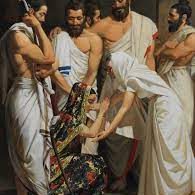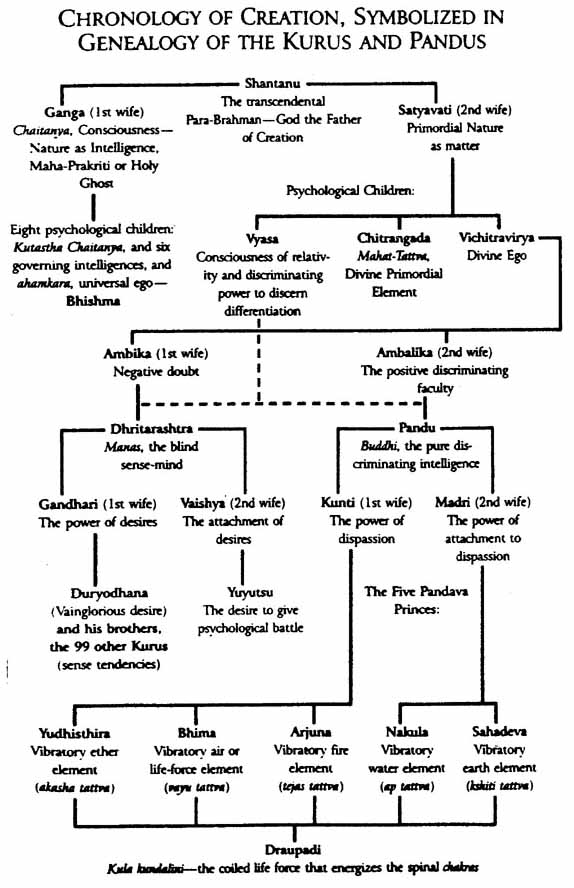All events are permanently recorded in the superether of omniscience, the akashic (etheric) record. They can be directly contacted by any advanced sage in any clime and age. -- An excerpt from God Talks With Arjuna(Paramhansa Yogananda)

The whole history of dynasty of king Bharata could be perceived by sage Vyasa ( or any other spiritually advanced sage), and then later he decided to write the legendary epic ‘Mahabharata’, as a spiritual metaphor taking inspirations from the actual happenings from past and based on historical characters and facts .
Summary of Mahabharata
A brief summary of Mahabharata touching upon the important characters and events would form the background for Bhagwadgita.
Paramhansa Yogananda has described Mahabharata as an allegorical(symbolic) intent of Vyasa, where inspirations were drawn from a historical dynasty and historical figures, corelating the characters and events to explain the deepest aspects of spirituality.
The story of Mahbharata begins three generations before Krishna and Arjuna, at the time of Maharaja Shantanu. Ganga was the first wife of Shantanu , who gave birth to eight sons out of which only one – ‘Bhisma’ could survive(becuase of a curse on Ganga). At the cost of Bhisma’s life Ganga immersed herself in the water.
Shantanu married another queen named Satyavati and got two sons from her named- Chitrangada and Vichitravirya. Both of them died without any offspring and the latter left two widows named ‘Ambika’ and ‘Ambalika’.
Sage Vyasa was born to Satyavati as a result of a boon by Rishi Prashar. As per the rule of land, Vyasa was persuaded to produce a progeny from the two widows to continue the succession of throne.
Thus , Pandu was born from Ambalika and Dhritrashtra(blind) from Ambika.
Dhritrashtra married Gandhari and got 100 sons called – ‘Kauravas’, and he had another son -‘Yuyutsu’ from his second wife Vaishya.
Pandu got three sons – Yudhisthira, Arjuna, Bhima from Kunti , and ‘Nakul’ and ‘ Sahdev’ from Madri. These children were produced by special chants which Kunti got from Rishi Durvasa.
The five Pandava princes and the one hundred Kaurava offspring were raised and educated together, receiving the tutelage of their preceptor Drona. Arjuna excelled all of them in prowess; none could match him. Jealousy and enmity grew among the Kauravas against the Pandus. Duryodhana resented Yudhisthira’s position as the rightful heir to the throne, so he conspired repeatedly but unsuccessfully to destroy the Pandus.

Arjuna married Draupadi in her Swayamvar, who later got married to all five brothers, because of an order of Kunti. Draupadi bore a son from each of the Pandavas.
The dispute between Pandavas and Kauravas reached at its peak over the rulership of the kingdom.
In a game of dice , arranged by Duryodhana, Yudhisthira was trapped and he lost all of his kingdom , then his brothers and then his wife- Draupadi. She was dragged in the court infront of everyone, and disrobed. At the end Krishna saved her modesty. This incident became the root cause of the war of Kurukshetra.
When war became inevitable, Arjuna for the Pandav and Duryodhana for the Kauravas sought Krishna’s aid in their cause. Duryodhana arrived first at Krishna’s palace and seated himself boldly at the head of the couch upon which Krishna was resting, feigning sleep. Arjuna arrived and stood humbly with folded hands at Krishna’s feet. When the avatar opened his eyes, it was, therefore, Arjuna whom he saw first. Both requested Krishna to side with them in the war. Krishna stated that one party could have his massive army, and the other side could have himself as a personal counselor—though he would not take up arms in the combat. Arjuna was given first choice. Without hesitation he wisely chose Krishna himself; the greedy Duryodhana rejoiced to be awarded the army.
Before the war began Krishna served as a mediator between them. He reached Hastinapur and presented a peace treaty on the behalf of Pandavas.
But even he could not move the power mad Duryodhana and his followers to accept a fair resolution, and war was declared; the field of conflict was Kurukshetra.

The war ended after eighteen days of numerous killings and casualities from both sides. Pandavas won the war, representing the victory of Dharma over Adharma.
Yogananda has related each of the characters of the epic and their descendence to the descendence of human traits from the supreme consciousness. The descent of the Kurus and Pandus from Shantanu parallels in analogy the step-by-step descent of the universe and man from Spirit into matter.
Sage Vyasa has covered every psychological traits as well as many metaphysical principles with a suitable Sanskrit name ,originating from a specific Sanskrit root ,describing the traits of the character using various poetic elements.
Chronology of Creation , symbolized in Mahabharata
The following image is from the book – ” God Talks With Arjuna(Paramhansa Yogananda)” .It describes – how the descendance of characters of Mahabharata describes the descendance of human soul from the supreme spirit – ‘The Parabrahman ‘.
